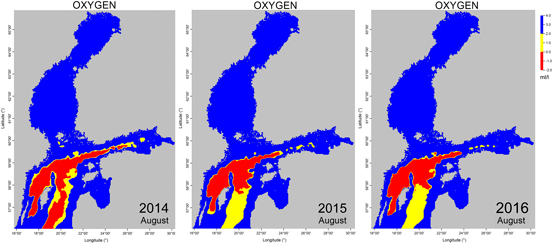Press release 2016-09-02 at 9:59
The effects of the major Baltic inflows that have arrived in 2014, 2015 and 2016 can be seen in the improved oxygen situation of the basins to the east and south of Gotland. The anoxic area of the seabed in the Baltic Sea has become considerably smaller compared to the summer of 2014, but the inflows have nevertheless not been able to completely oxygenate the hydrogen sulphide-rich water in the depths of the Baltic Proper. The impact of the old waters from the Gotland basin that the inflow has pushed ahead in front of it is visible in the mouth of the Gulf of Finland. However, the inflows have not had any significant effect on the condition of the Gulf of Finland. The results are based on the research trips of the research vessel Aranda during the past summer.

Salinity from the Gotland basin to the Gulf of Finland in August 2014, 2015 and 2016 © SYKE
The Gotland basin still has oxygen
The impact of the salty, oxygen-rich water that flowed into the Baltic Sea via the Danish straits was still visible on the research trips during the summer of 2016 in the deep basins to the south and east of Gotland. The salinity of the water has continued to rise compared to last summer; this may be due to the new Baltic inflow last winter, whose volume was much smaller than the previous one, but nevertheless significant.
Like last summer, the water in the basins to the north and west of Gotland is anoxic, because the Baltic inflows have not been enough to oxygenate the large anoxic and hydrogen sulphide-rich water masses collected in the basins.
The increased salinity discovered in the basin of the Sea of Åland is also likely due to the impact of the inflows. In contrast, the salinity in the Bothnian Sea and the Bay of Bothnia is at the same level as in previous years, and the oxygen situation in these sea areas has remained good. No significant amount of the deep water in the Baltic Proper can flow into the Gulf of Bothnia due to the thresholds in the seabed.

Oxygen situation near the seabed in the Baltic Sea in August 2014, 2015 and 2016 © SYKE
The oxygen situation in the Gulf of Finland is relatively good
The oxygen situation in the open sea basins of the Gulf of Finland was reasonably good in August. Hydrogen sulphide was only found in the basins near the coast of Estonia and at the mouth of the Gulf of Finland. The Baltic inflows have not reached the Gulf of Finland; instead, they have stopped at the northern parts of the Baltic Proper. However, the inflows have pushed ahead old eutrophic water from the basins of the Baltic Proper in front of them, which can be seen in the low oxygen content and high nutrient amounts in the basins at the mouth of the Gulf of Finland. The Gulf of Finland is directly connected to the Baltic Proper without a lower isolating threshold, which is why the deep water from the Baltic Proper can flow freely into the Gulf of Finland.
In the Russian waters in the eastern Gulf of Finland, the oxygen content near the seabed was good, which is why the nutrient content close to the bottom was also relatively low.

Phosphate phosphorus from the Gotland basin to the Gulf of Finland in August 2014, 2015 and 2016 © SYKE
No significant changes in the situation of the seabed in open sea areas
No significant changes were found in the situation of the benthic communities in the Gulf of Bothnia compared to earlier. In the Baltic Proper and the Gulf of Finland, recolonisation by certain hardy species has been detected as the oxygen situation momentarily improves, but the situation usually worsens again relatively quickly as the oxygen near the seabed disappears.
There is no recent information available on the status of the coastal seabeds, because the trip of the research vessel Muikku was interrupted by technical problems soon after departure. The interrupted trip was supposed to be the last of the elderly vessel. Planning the continuation of the monitoring of coastal waters and seabeds of the Finnish Archipelago Sea and the Gulf of Finland, which has been carried out by Muikku since 1999, has already begun.
What kind of impact will the major Baltic inflows have in the future?
So far, the inflows in the recent years have halted the expansion of the anoxic area of seabed in the Baltic Proper. The inflows and their resulting impact are likely to continue to affect the situation in the Baltic Proper and the functioning of the ecosystem, and they are also indirectly reflected in the situation of the Gulf of Finland and the Gulf of Bothnia. The SYKE Marine Research Centre will continue to monitor and study the major Baltic inflows and their effects together with other institutions studying the condition of the Baltic Sea and provide information about the results.
See also:
More information:
Aranda:
Cruise leader, Senior Research Scientist Maiju Lehtiniemi, SYKE
tel. +358 295 251 356
firstname.lastname@ymparisto.fi
Cruise leader, Senior Researcher Pekka Kotilainen, SYKE
tel. +358 295 251 317
firstname.lastname@ymparisto.fi
Major Baltic inflows:
Leading Researcher Kai Myrberg, SYKE
tel. +358 295 251 441
firstname.lastname@ymparisto.fi
Images:
Salinity from the Gotland basin to the Gulf of Finland in August 2014, 2015 and 2016 (1500px)
Oxygen situation near the seabed in the Baltic Sea in August 2014, 2015 and 2016 (1500 px)
Phosphate phosphorus from the Gotland basin to the Gulf of Finland in August 2014, 2015 and 2016 (1500 px)
Aranda:
Photographer Copyright © Panu Hänninen
Aranda 1 (3000 px)
Aranda 2 (4000 px)
Aranda 3 (4000px)